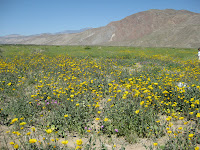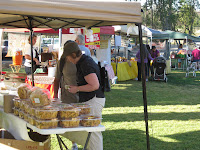An episode on the KPBS-TV show Wonderland San Diego inspired us to do a "staycation" day trip to Oceanside. Noah Tafolla did a great job identifying attractions worth seeing and experiencing.
 We recommend Thursdays for a day visit, when Oceanside's Certified Morning Farmer's Market, is held from 9 a.m. to 1 p.m. along Pier View Way, virtually in front of several of the main attractions. Incidentally, there is a Sunset Market held Thursdays 5-9 p.m., also along Pier View Way, if you're spending an evening there. Both of these events are associated with Main Street Oceanside, an organization devoted to enlivening downtown Oceanside.
We recommend Thursdays for a day visit, when Oceanside's Certified Morning Farmer's Market, is held from 9 a.m. to 1 p.m. along Pier View Way, virtually in front of several of the main attractions. Incidentally, there is a Sunset Market held Thursdays 5-9 p.m., also along Pier View Way, if you're spending an evening there. Both of these events are associated with Main Street Oceanside, an organization devoted to enlivening downtown Oceanside. We found ample, unlimited on-street parking just north of the Civic Center and Library. Since we were a bit early for the museums, we decided to scope out the Farmer's Market. It's quite extensive, offering prepared foods as well as the usual organic produce and souvenirs. We decided early on that we would have lunch at one of the food stands.
We found ample, unlimited on-street parking just north of the Civic Center and Library. Since we were a bit early for the museums, we decided to scope out the Farmer's Market. It's quite extensive, offering prepared foods as well as the usual organic produce and souvenirs. We decided early on that we would have lunch at one of the food stands.The Oceanside Historical Society Museum, 305 N. Nevada Street, occupies a corner of the 1929 Fire Station No. 1, designed by famed Modernist San Diego architect Irving Gill. Although it's a small space, it has extensive archives of Oceanside's history. Among the more unusual artifacts exhibited in the Museum are two beer containers (with contents?) dating from the end of Prohibition. Open Thursday, Friday and Saturday, 10-2. Free admission.

 Right next door is the Oceanside Museum of Art, 704 Pier View Way. Its architectural design is an amalgam of sleek modern glass of the Central Pavilion, which houses the museum proper, combined with the arcaded Mission Revival style of the Museum Store building, part of Gill's 1934 Oceanside City Hall. The Central Pavilion's architect, Frederick Fisher, received an Orchid award in 2008 for a successful 21st-century minimalist design that respects the historic fabric of Irving Gill's adjacent civic buildings. Open Tuesday-Saturday 10-4, Sunday 1-4, closed Mondays and major holidays. Admission (2010): General $8, Seniors 65+ $5, Free to military personnel and their dependents with IDs, and to students with IDs.
Right next door is the Oceanside Museum of Art, 704 Pier View Way. Its architectural design is an amalgam of sleek modern glass of the Central Pavilion, which houses the museum proper, combined with the arcaded Mission Revival style of the Museum Store building, part of Gill's 1934 Oceanside City Hall. The Central Pavilion's architect, Frederick Fisher, received an Orchid award in 2008 for a successful 21st-century minimalist design that respects the historic fabric of Irving Gill's adjacent civic buildings. Open Tuesday-Saturday 10-4, Sunday 1-4, closed Mondays and major holidays. Admission (2010): General $8, Seniors 65+ $5, Free to military personnel and their dependents with IDs, and to students with IDs. Three blocks west of the Museum of Art is the California Surf Museum, 312 Pier View Way. It moved into its new location on February 16, 2009. They had an impressive exhibit of women surfers while we were visiting. Open daily 10-4, Thursday to 8 p.m. Closed major holidays (check their Web site). Admission (2010): General $3; Seniors, Military and Students $1; free to kids under 12.
Three blocks west of the Museum of Art is the California Surf Museum, 312 Pier View Way. It moved into its new location on February 16, 2009. They had an impressive exhibit of women surfers while we were visiting. Open daily 10-4, Thursday to 8 p.m. Closed major holidays (check their Web site). Admission (2010): General $3; Seniors, Military and Students $1; free to kids under 12. As we were walking back to the Farmer's Market for lunch, we spotted this mural, painted on the west side of the Surf Museum's old location at 223 N. Coast Highway.
As we were walking back to the Farmer's Market for lunch, we spotted this mural, painted on the west side of the Surf Museum's old location at 223 N. Coast Highway.We decided to settle at the one table located at the tamale food stand for our meal. Marie had one of the "lard-free" tamales ($2.50) while Doug had a fish burrito ($5) bought from an adjacent vendor. We had fun chatting with the tamale stand's owner and a local habitué who had just come over from his daily Web "surfing" session at the nearby library.




 Another attraction located about a mile west of the Mission is Heritage Park Village and Museum, 220 Peyri Drive. We decided to stop by before heading back to Oceanside. Note: access to Heritage Park from the direction of the Mission is tricky: El Camino Real, the old access road northwest of the Mission, is closed to public access, despite what the maps say. Drive back to Mission Avenue, turn right (north) on Douglas Drive (begin following "historical point of interest" signs), turn right (east) on El Camino Real to Peyri Drive, continue to the park.
Another attraction located about a mile west of the Mission is Heritage Park Village and Museum, 220 Peyri Drive. We decided to stop by before heading back to Oceanside. Note: access to Heritage Park from the direction of the Mission is tricky: El Camino Real, the old access road northwest of the Mission, is closed to public access, despite what the maps say. Drive back to Mission Avenue, turn right (north) on Douglas Drive (begin following "historical point of interest" signs), turn right (east) on El Camino Real to Peyri Drive, continue to the park. Marie wanted to take a look around Oceanside Harbor as our final stop. Note the lighthouse in a Cape Cod-like setting. Noah Tafolla of Wonderland San Diego fame recommends the Harbor Fish and Chips Restaurant as a good place for fish tacos. This is where we would have had lunch if we hadn't found the Farmer's Market. We returned home after the harbor visit. Approximate distance: 75 miles from our home in Pacific Beach.
Marie wanted to take a look around Oceanside Harbor as our final stop. Note the lighthouse in a Cape Cod-like setting. Noah Tafolla of Wonderland San Diego fame recommends the Harbor Fish and Chips Restaurant as a good place for fish tacos. This is where we would have had lunch if we hadn't found the Farmer's Market. We returned home after the harbor visit. Approximate distance: 75 miles from our home in Pacific Beach.
 A worthwhile detour: During the spring (mid-March to mid-May), make a stop at the Carlsbad Flower Fields, 5704 Paseo del Norte (just off Interstate 5 Freeway and the Palomar Airport Road exit). Although the showiest flowers are ranunculus, there are other species represented, such as roses. Open daily 9 a.m.-6 p.m. during the season. Admission (2010): General $10, Seniors 60+ $9, Children 3-10 $5, Children 2 or under, free. Discounts are available online.
A worthwhile detour: During the spring (mid-March to mid-May), make a stop at the Carlsbad Flower Fields, 5704 Paseo del Norte (just off Interstate 5 Freeway and the Palomar Airport Road exit). Although the showiest flowers are ranunculus, there are other species represented, such as roses. Open daily 9 a.m.-6 p.m. during the season. Admission (2010): General $10, Seniors 60+ $9, Children 3-10 $5, Children 2 or under, free. Discounts are available online.


































